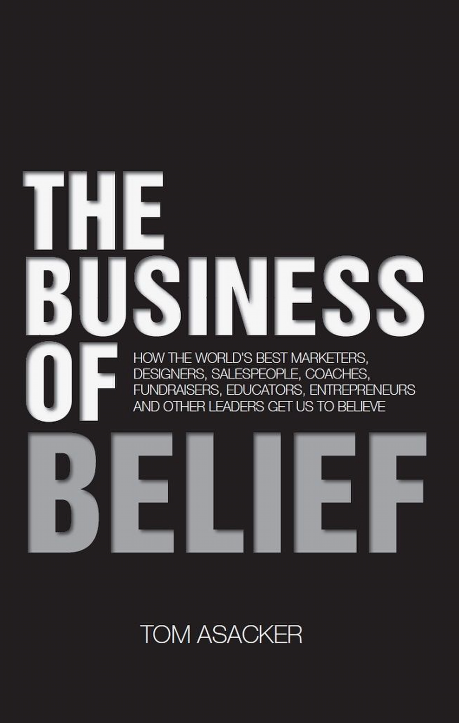 My digital copy of The Business of Belief by Tom Asacker has more highlights marks in it than any book I’ve read in months, or possibly years. That’s saying more than it might seem. The book was short, I was finished in less than 3 hours. 3 wonderful hours. I found the book in my Kindle library, though I can’t say I remember buying it. I’m glad I did.
My digital copy of The Business of Belief by Tom Asacker has more highlights marks in it than any book I’ve read in months, or possibly years. That’s saying more than it might seem. The book was short, I was finished in less than 3 hours. 3 wonderful hours. I found the book in my Kindle library, though I can’t say I remember buying it. I’m glad I did.
First, the tagline, “How the world’s best marketers, designers, salespeople, coaches, founders, educators, entrepreneurs and other leaders get us to believe”, hardly represents the book at all. It’s not a how-to. It is not a how to book. Thank god.
It’s more like philosophy, using a lot of business analogies. Or, some kind of business minded religious text. Seriously, some of it appears to be written in verse. Take this excerpt:
If I say, “It was a dark and stormy.”
You connect the dots and think “night.”
But why didn’t you think “cocktail?”
After all, there is a drink called “Dark and Stormy.”
It’s made with dark rum, ginger beer and lime.
If you’re driving and a ball comes flying across the road in front of you (click), your mind thinks (whirr), “Kid!”
A similar process arises when you’re first exposed to a website, an advertisement or a salesperson.
Your present passes through a filter of your past to create spontaneous meaning.
When you see the word “swastika,” what meaning do you create?
“Swastika” comes from the Sanskrit “svastika.”
It literally means, “to be good.”
It’s a good luck symbol.
But in 1920 it was adopted by the Nazi Party.
And now the click of “swastika” creates an emotional whirr of hate.
Everything is inherently without meaning.
Except for the meaning we create.
Now, to be perfectly clear, this “verse” is probably just a Kindle formatting issue. But my belief that it was written in verse added so much to my appreciation of the text. And that experience for me, pretty well sums up the book’s point.
As Asacker explains, and I’ve read elsewhere, humans go on their ‘gut’ first, and then rationalize second. If you see something menacing on a path during a hike, you jump back first without thinking about it. Immediately thereafter, you rationalize with ‘snake’. We’re also creatures that long to be consistent with our words, actions and beliefs. If it had simply been a managing looking tree branch in the path, the inconsistency between the belief that it was a snake and the reality that it was a branch might lead to embarrassment and the rational capacities would rush in to create a new belief which made those two things consistent.
According to Asacker, belief is an illusion. Or, the object of belief is an illusion. Belief is more like a short cut. They allow us to resolve cognitive dissonance between words and actions. They allow us to be lazy.
In one example, he describes walking into the bathroom of your hotel suite and noticing fresh soap and neatly folded toilet paper rolls. Upon seeing that, a spontaneous belief is created. The cleaning staff was here and they cleaned the room. Of course, you didn’t check the sheets. The carpet fibers, the inside ring of the toilet, or the stock of towels under the sink. Instead, all of those things were lumped into a belief based on a couple tiny details.
Belief is a shortcut, a necessary one. Asacker isn’t saying not to believe, he wants us to understand what it is.
Like moths to a flame, we’re instinctively drawn by our desires to a plethora of choices. And the motivation for our decisions are driven by the vivid narratives we spontaneously create. Our brains have evolved to work that way, to transform reality by making up cause and effect stories.
Beliefs are born from desire. The desire to acquire something. To be something. To avoid something. Desire creates belief. If I want a cheeseburger, I may remember my week and see a narrative where I worked really hard and deserve a cheeseburger. My belief, is that I deserve that cheeseburger. But the belief didn’t start rational. It started with the desire and was rationalized into belief. On the other hand, if I wanted a cheeseburger, but even more than that I wanted a slimmer waistline, I might see a narrative over my last week where I worked really hard, but didn’t get very much exercise because of that. I wouldn’t get the cheeseburger. But again, it wasn’t rational. It started with a desire to be slimmer, and was rationalized into a belief that the cheeseburger is too calorically expensive.
Emerson once remarked that there is properly no history, only biography. The stories we create about the past aren’t the Truth (with a capital T). They’re a personal fiction, the mind’s meaning-making apparatus at work. But, like most everything the mind creates, it affects us. How we visualize each role in each scene not only shapes how we think about ourselves, but also how we behave. Who we think we are is why we do what we do.
I think it’s easy for people to take concepts like these and feel defensive. We want our beliefs to be rational, not rationalizations. There’s a knee jerk reaction likely here. One that will probably be rationalized as something like “Asacker is full of shit.” But I think he’s right on the money, and I think it’s a good thing. Most of us nearly deify our rational faculties–our rationality macros; our beliefs.
But what if you want to throw a bullseye on a dart board? Which is greater, the desire for the bullseye, or the desire not to fail over and over? A strong enough desire for the bullseye will rationalize all the failures into a belief that “it’s difficult at first and it takes practice”. In this case, that belief is true and given enough time, you’ll get that bullseye. And soon you’ll be able to get that bullseye a lot. But if the desire not to fail is stronger, you might rationalize that into the belief that you just don’t have the chops for darts. Goodbye bullseye.
The sentiment here reminds me very much of something I read from a Christian theologian, RC Sproul, many years ago: “People always act according to their greatest desire.” It could be more completely said, “People always act according to their beliefs, or, they make new beliefs”.
There’s so much more interesting insight than I can recap in one little book roundup. The heart of it, however, is much like the idea of ‘keeping your eye on the ball’. By recognizing that desire + rationality = belief, we can influence all three. By knowing that after desire will come some kind of rationality, we can step in and influence our desires, influence the rationality and develop beliefs that are more congruent and rewarding.
This book might be written for the business heads, but it’s widely applicable. It’s a super-easy read, and I recommend it to almost anyone hoping to guide their own path in life.

Recent Discussion